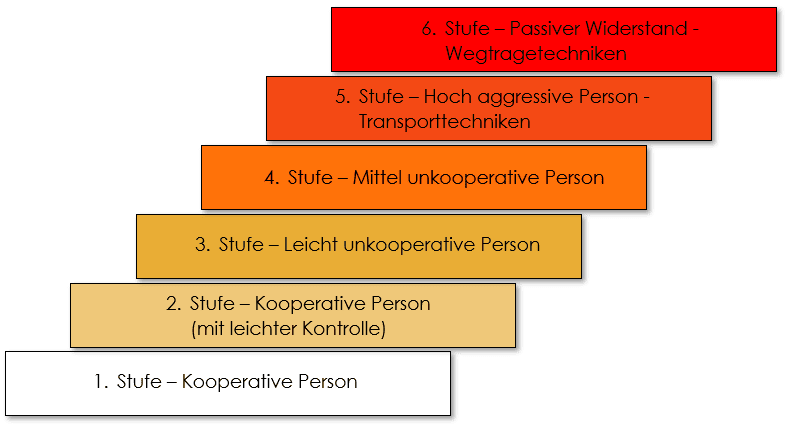The most important parameters for training with teams:
- Joint team training
- Simple system design
- Few striking techniques (risk of injury, proportionality)
- Mission/objective - to gain control over a person (situation)
- Available under stress
- A simple concept
- Consideration of the starting position (passive resistance, tight spaces, team interaction, access etc.)
- Transferability (with and without resources)
- Modular design
- Modern teaching methods
What does teamwork mean to us?
Teamwork means that work tasks are performed and carried out by several people at the same time. Optimal teamwork is characterized by the sensible distribution of individual tasks.
Teamwork is relevant for the areas of communication, operational tactics, deployment techniques, fixing techniques, transportation and tactical self-protection techniques.
Tactical team formations
An important role in teamwork is the optimal tactical positioning and deployment of the Teams to the potential aggressor(s). Through targeted action from this formation, access techniques and accompanying techniques can be optimally realized in the team.
- L-formation
- T-formation
- V-formation
- O-Formation (Ring Formation)
- Line formation
Team operational tactics
Operational tactics refers to a planned, coordinated operation using verbal and physical means to enforce necessary measures. Important factors for implementation are strength (team), time, space and purpose.
The operational tactics include:
- Preparation for use
- Tactics and strategy
- Team agreements / team language
- Personal safety / team protection
- Use of physical force
- Use of resources
- Positioning in the team
- Accompanying techniques in a team
- Access techniques in the team
- Fixation techniques in a team
- Transportation techniques in a team
- Perception
- Information processing under stress
AN EXAMPLE - SAMI-X PRO - 6 STEPS ACCOMPANYING TECHNIQUES TABLE
The right accompanying techniques play an important role in teamwork (teaming) when dealing with non-aggressive Persons. By escorting techniques in the SAMI-X PRO, we mean the tactical and optimum positioning when "escorting" and the correct gripping of the safety personnel when non-aggressive persons. Targeted action from this accompanying position means that access techniques can be optimally implemented in the team in an emergency.
This controlled escorting is the prerequisite for safe action with less risk for the security personnel. The concept presented here distinguishes between six different levels of situation when dealing with people. We only use escort techniques in the SAMI-X PRO up to level 4. After that, transportation techniques or removal techniques are used. Each of these stages is an indispensable building block for the optimal handling of violence and aggression. According to the stage of aggression development, these stages can be represented as follows:
